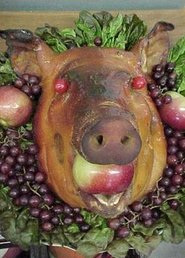In this week's Claire Chats video I talk about the staple diet of the majority of the Tudor population.
Useful Links
- Tudor Monastery Farm Episode 3 - for information on ale and breadmaking.
- www.peterandrewryan.com/baking/2008/11/european-peasant-bread/ - For an European Peasant Bread recipe.
- www.otterton-primary.devon.sch.uk/POTTAGE.pdf - For a pottage recipe.
Sources
- Tudor Monastery Farm: Life in Rural England 500 years ago by Ruth Goodman, Peter Ginn and Tom Pinfold
- Everything You Ever Wanted to Know About the Tudors but Were Afraid to Ask by Terry Breverton
- Food and Feast in Tudor England by Alison Sim
- www.theguardian.com/lifeandstyle/2013/mar/29/gardening-tudor-vegetables
- http://secret-garden-club.blogspot.com.es/2012/06/all-things-bright-and-beautiful-edible.html



That was interesting, I didn’t think about food in the Tudour times but it looks as though the country folk were much healthier then the upper classes
Yes, it’s funny that the wealthy looked down on vegetables because they could afford meat. The lower classes were definitely healthier and fitter.
LOL, still laughing at the eating of ‘Farts’… to be quite honest with that amount of grain, lentils, dried peas etc…I bet there was a lot of that going on too :). If ol’ Henry had had all that fibre in his diet as the ordinary folk did, he wouldn’t have had the constipation he suffered with!!
I really enjoyed that chat Claire…thanks.
Claire when you have a few moments (which is perhaps very rare these days) I want to pick your brains a little. I know the era I am writing about is not really your cup of rosie, but I have a little storyline I’d like to play with concerning Haggeis (haggis).
The first spelling is looks a bit strange, but Haggeis is the original gaelic word for it. I don’t believe Haggis would have been eaten at this time by the nobility of Scotland, it would have been known of, and in fact it is first mentioned as being called Haggeis in a poem by William Dunbar in 1520. There is however a reference to it in an old lancashire recipe book under it’s english name of “hagws” or “hagese” in 1430, if this is is one and the same thing is open to speculation.
It was Robbie Burns and his poem Address to the Haggis 1787 that really made the Haggis popular, and as you know Burns night is the Haggis’s birthday (for want of a better word) There is a sort of strict sort of conduct to eat the Haggis on Burns night, it is carried to the table on a silver platter to the sound of a Scottish piper (i’m guessing it’s “Scotland the Brave” that’s played) Robbie Burns poem is read out and then the haggis is cut into slices with a Claymore Sword, and serves with mashed tatties and neeps (Potatoes and Turnips before spuds were brought to England by good old Sir Walter, and became popular, I would imagine it was just with neeps.) with a dram of whiskey poured over the Haggis.
Anyway I’m waffling, you probably know all this.. The idea I’m playing with is that Mary has her first taste of Haggis on her summer progress into the border lands. I am pretty certain that this is not something she would have been served in a nobleman’s household, as it is or rather was at that time considered a poor man’s meal. So could I get away with using a Haggeis storyline in a Convent or Abbey?
I would be interested to hear your opinion on this.
Unfortunately, Lorna, I haven’t got a clue! I’ll ask Dawn as she knows quite a lot about Scottish history and food and such like. Sorry!
Thank you Claire.
Scottish history is certainly very complicated, but to be honest I’m enjoying the challenge. To borrow your sentiment on one of the forum pages “I love what I do”
There isn’t a set tune for piping in Mr. Haggis, but usually ‘A man’s A Man for A’ That’ or ‘Star O’ Rabbie Burns’ tend to be favourites, and have you seen the size of a Claymore Boleyn!!!, lol, it’s a two handed long sword… 🙂 you would do more than slice the haggis waving that about, lol…its done with a dagger type knife that is sharpened over the poor ‘creature’ when you get to the line of the poem ‘His knife see rustic labour dicht’…and before the piper comes in there is the Selkirk Grace, a small prayer.
The Scot’s take Burn’s Supper very seriously, and it does have a strict protocol like you say,and dress code if you are doing it 100%, its very interesting reading, all available to read on the net, as per…
All in all I have lived up here for 8 yrs first time and 14 yrs this time and I have never been to one…why? I don’t know, perhaps because when it’s on your own door step you tend not to, how many of us do that, daft really isn’t it. I must go to one, it would be rude not too, lol.
From what I have looked at there is no record that I can find on Mary eating Haggis, by choice anyway…it was peasant food really.
It seems with Mary’s mother, Mary of Guise coming from France that Scottish cuisine for the Nobles at court had become very sophisticated, more so than England, and by the time MQofS came back to Scotland to take over the ‘family business’ bringing her French Entourage too, it became even more so…so it seems there was little chance of her indulging in the haggis, unless she was served it on her stays in captivity in Scotland, like Loch leven, where I can’t imagine she was catered for to a high standard…who knows when you are on the run you would eat what you could get.
Though shortbread is attributed to our Mary, it is said she was very fond of her ‘petite gatelles’ (little cakes), from which ‘Petticoat Tails’, (the traditional triangular shape shortbread was cut into), was a corruption of. This shape of cutting the shortbread is attributed to Elizabeth, copying the shape of her full-gore petticoat pattern….yet again it is also said the origins of short bread comes from the 12th century all over Britain and it’s Isles, when it was a bread based dough ‘Biscuit Bread’. Biscuit meaning twice cooked., this was slow dried in the oven to harden.
It developed through time with the yeast being replaced by butter, perhaps this happened when the French cooks arrived up here, sometimes flavoured with caraway seeds. Butter being a luxury for the ordinary folk, were only baked on special occasions such as Hogmanay.
We can’t actually credit Scotland with the Haggis, its thought/debated it came across the water in a log-boat from Scandinavian shores, or as far back as the Romans, some say it derived from England.
To be honest if we look at all countries from earlier times there is a type of ‘sausage’ that is made up of offal, bits of meat that the rich didn’t eat, and the poor did, and they tried to make it tasty,filling and warming.
It is thought that perhaps these ‘sausages’ started when an animal was gutted after the kill; game has to be ‘Gralloched’ (the correct term), as soon as possible to ensure rapid heat loss of the carcass to stop deterioration of the animal. But when a Lairds/Nobles required a domestic animal to be slaughtered, out of the kindness of their hearts they let the workers keep the offal for themselves and this was put into the intestines to make it easy to carry home, the earliest form of carrier bag 🙂 for some reason the Scots seemed to have adopted this ‘type’ of sausage as their traditional dish, while England etc developed their own variations of recipe.
I have no doubt there are many stories of how these types of boiling sausage developed or originated from by those much more in the know than me, this is just the wee bits and bobs I have found.
But I know one thing, even though Haggis, Tatties and Neeps doesn’t look the most appetising meal to lay your eyes on, but it’s delicious, well I think so anyway, especially with a ‘wee dram’.
The best of them are bought from our local butcher, we have 3 good butchers in our small town, and each shop has their own recipe variation, spoilt for choice!
silly me…not a ‘log-boat’ a LONG-boat, lol.